I. Intro to DWC
Deep Water Culture systems, commonly known as “DWC” systems, represent the marriage of simplicity and efficiency. As a method for hydroponic growing, these systems provide an accessible entry point into the world of hydroponics. With their popularity soaring among both hobbyists and commercial growers, DWC systems have proven their worth as a top choice for interested growers.
Hydroponics, not to be confused with aquaponics, involves growing plants without soil, using a water/nutrient mix. This technique has gained significant attention due to its sustainability and efficiency. DWC systems exemplify these attributes, promoting rapid plant growth and high yields, all while offering an easy and affordable setup.
II. How Deep Water Culture Systems Work
To understand how DWC systems work, it’s vital that you first know the components. The primary trio making up most systems includes a reservoir, an air pump, and a net pot. But how do they interact to create a nurturing environment for your plants?
Visualize a plant, perhaps a lettuce head, gently positioned atop a reservoir like a 5-gallon bucket. The roots of the plant don’t bury themselves in the soil, as they would traditionally. Instead, they dangle freely into the reservoir filled with a nutrient-rich water solution. Normally, this would drown the plant, but the DWC system has an innovative solution!
An air pump, connected to the system, infuses the water with oxygen. An air stone bubbles this oxygen through the water, ensuring that it reaches the submerged roots. Thus, the roots absorb both nutrients and oxygen from the water, providing the plant with everything it needs to grow.
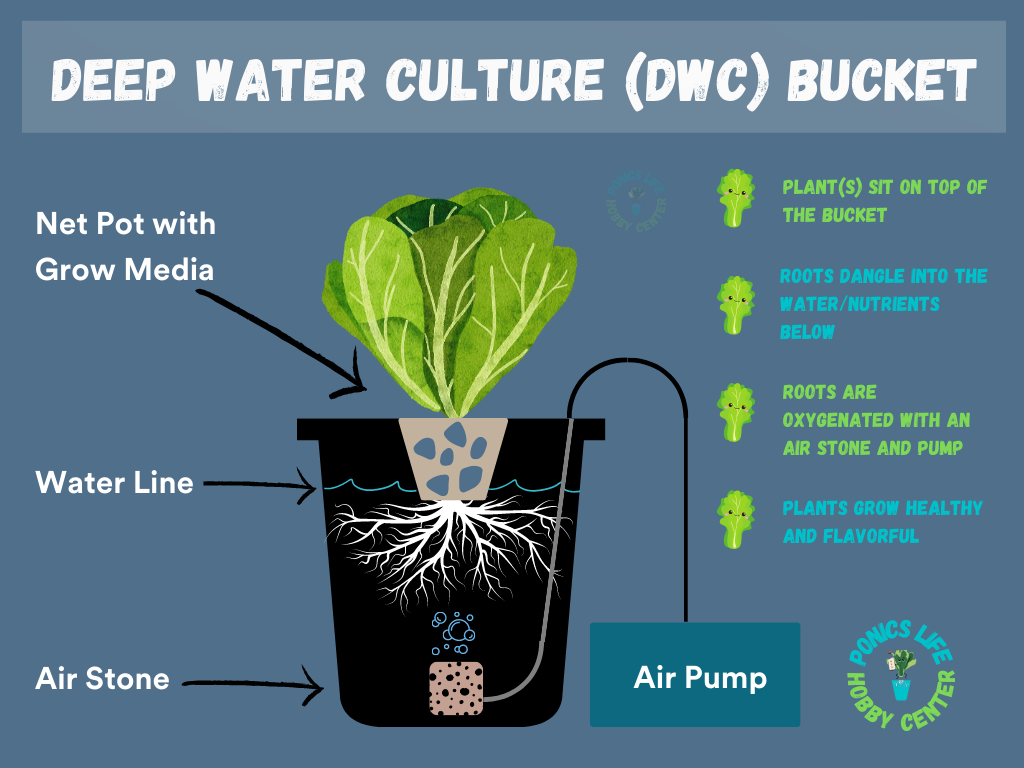
III. Deep Water Culture System Variations
DWC systems have multiple variations, each with its own unique setup and advantages. Here’s a look at some of the more common types:
Regular Deep Water Culture: This is the traditional DWC setup we’ve discussed so far. It’s a stand-alone system where each plant sits on top of a central reservoir, making it perfect for hobbyists and beginners exploring hydroponics.
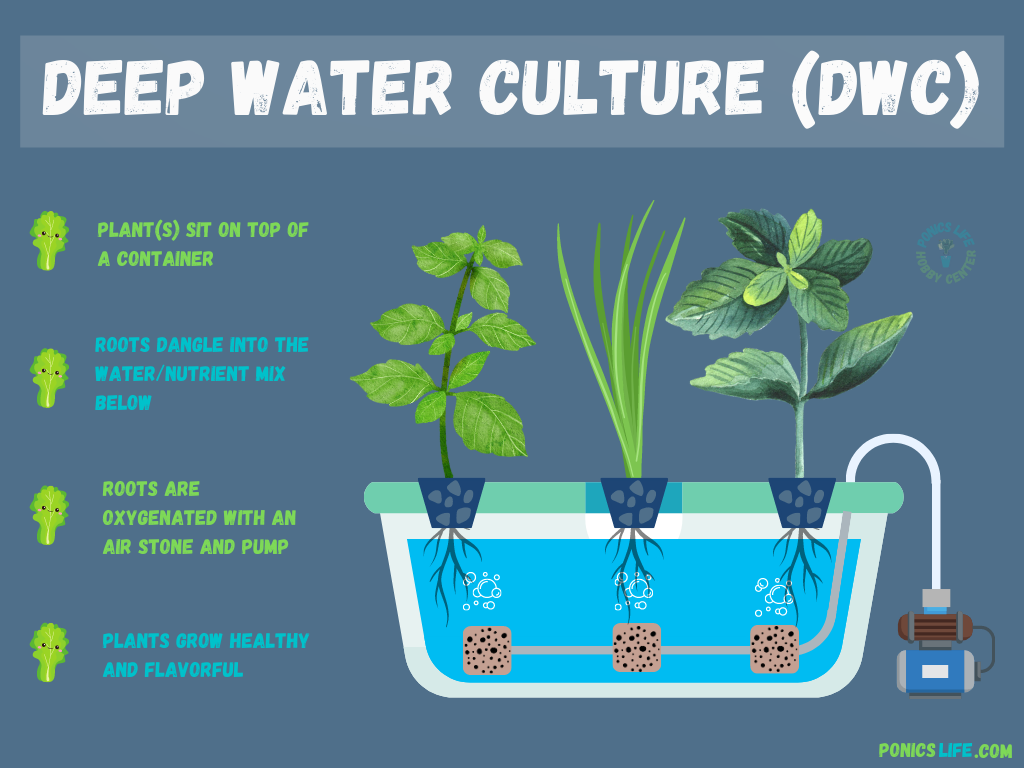
Recirculating Deep Water Culture: Also known as RDWC, this system takes the regular DWC setup up a notch. In RDWC, multiple buckets or containers are interconnected, allowing the nutrient solution to circulate between them. This setup enhances nutrient availability and reduces individual bucket maintenance.
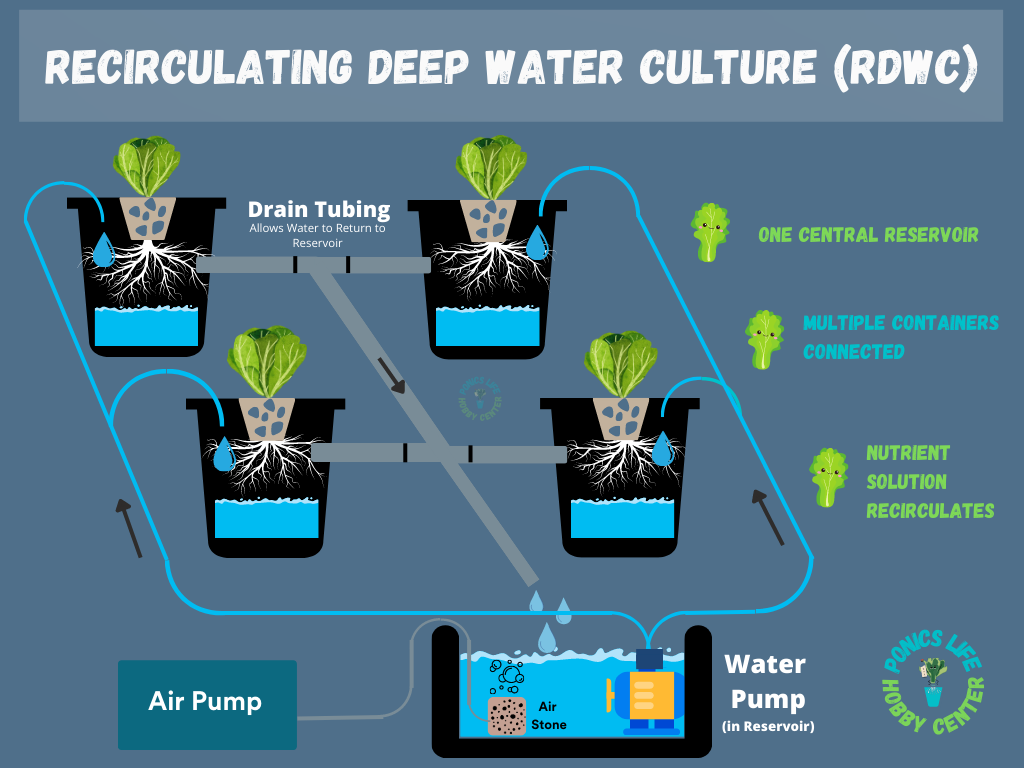
Raft Systems: Ideal for growing leafy greens and herbs, raft systems suspend plants on floating styrofoam rafts. The plants’ roots hang down into the nutrient solution, absorbing both nutrients and oxygen directly from the water. It’s a simple and effective method widely used in both commercial and home settings.
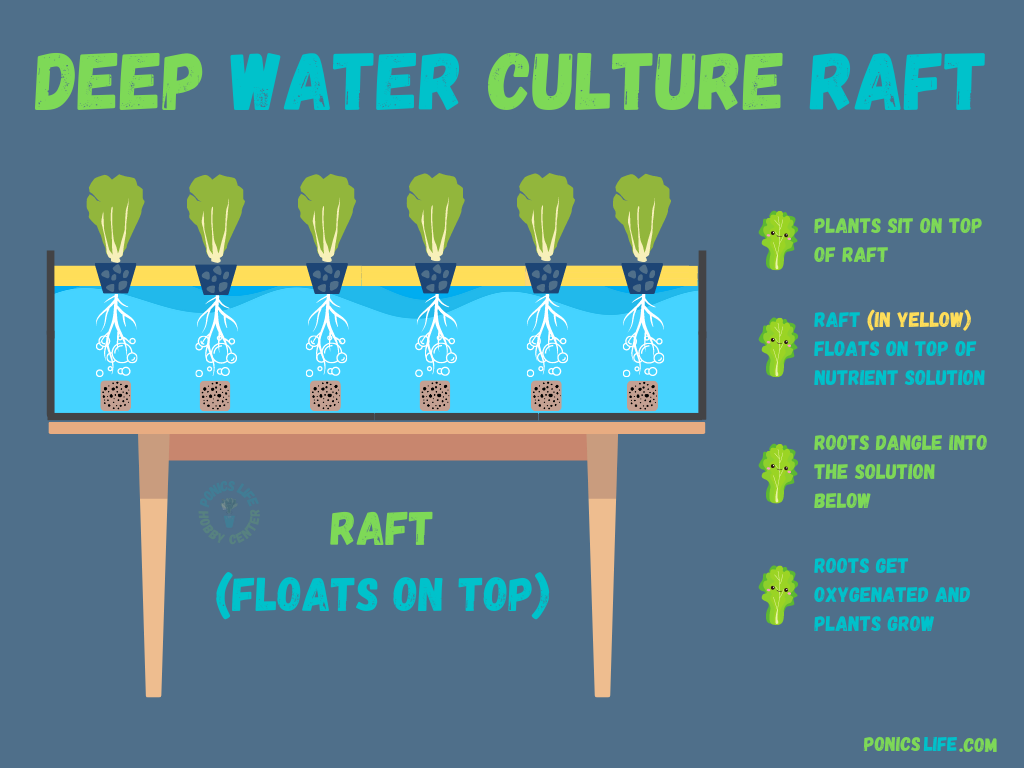
Commercial Raft Systems: As the name suggests, these are large-scale raft systems designed for commercial production. These systems efficiently produce large quantities of leafy greens in greenhouses or other controlled environments, contributing significantly to the commercial hydroponics industry.
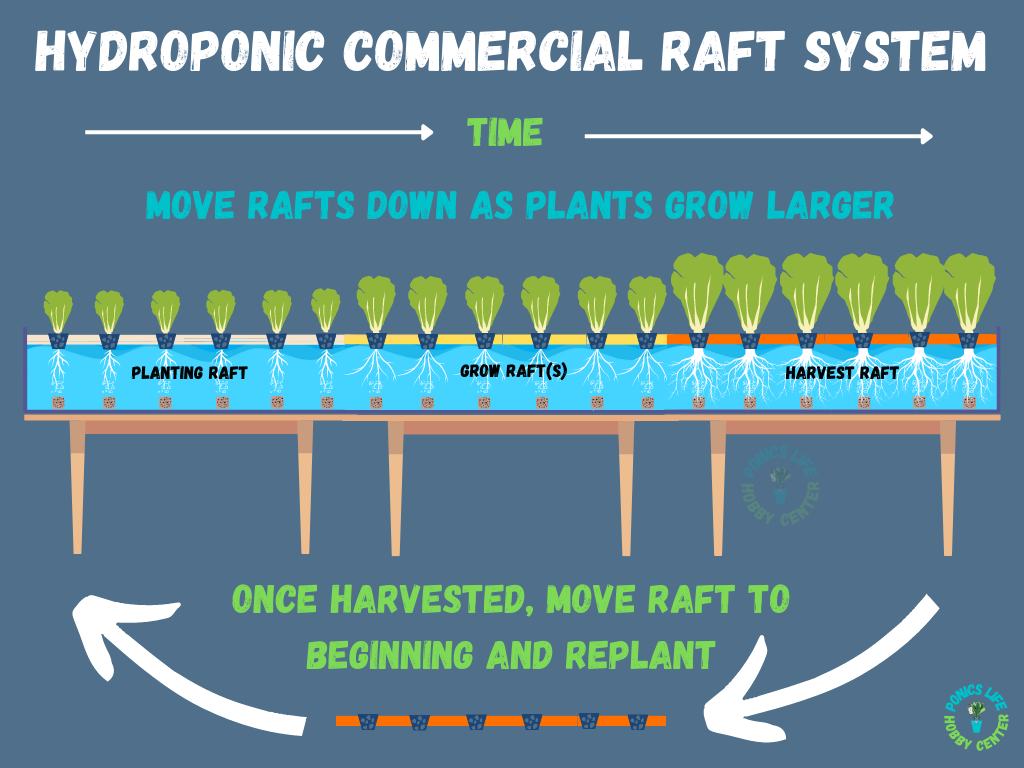
Bubbleponics: Technically a variant of DWC, Bubbleponics is designed to speed up the initial growth phase. This system introduces a top-feed drip system, showering the root zone with nutrient solution. The enhanced oxygen and initial nutrient supply accelerates plant development.
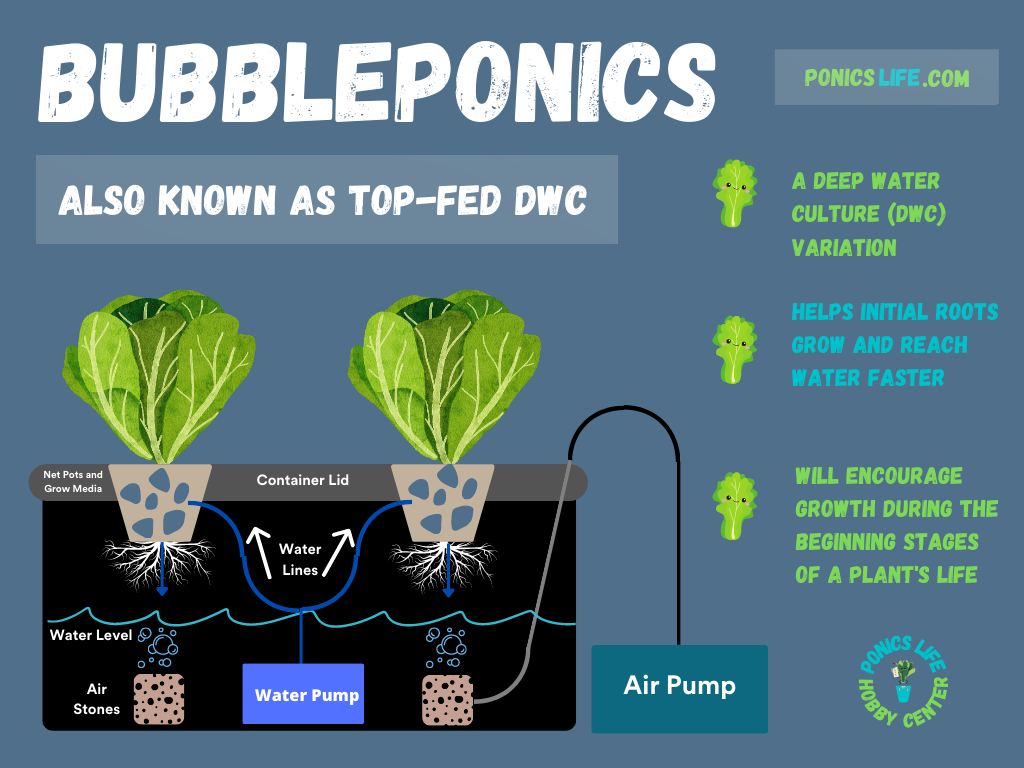
IV. The Unlimited Potential of Designing DWC Systems
When it comes to designing Deep Water Culture (DWC) systems, the sky really is the limit. Particularly for hobbyists, DWC systems offer an unparalleled platform for innovation, customization, and experimentation.
Perhaps you wish to optimize a compact setup for your apartment, or maybe you’re interested in engineering an expansive outdoor operation. Either way, there’s more than one way to crack an egg. If the fundamentals are met (water, oxygen, nutrients, and light), DWC systems can be tailored to suit your needs, space, and resources, and can be designed as simple or as complex as you want.
Moreover, these design possibilities don’t just stop at the system level. Components like reservoirs, air pumps, grow lights, and grow mediums can also be customized to fit your needs. From repurposing household items to using advanced hydroponics equipment, you have the freedom to design and build a system that’s uniquely yours.
Ultimately, DWC systems embody the essence of hydroponics: merging science with creativity. As you learn and grow with your system, you may find yourself developing new methods and practices that could reshape the way DWC systems are understood and utilized.
V. Grower Usability
Accessing and using DWC systems requires minimal prerequisite knowledge or skills. Anyone from curious beginners to experienced hydroponic gardeners can set up and manage DWC. The core philosophy behind DWC systems is simplicity, making them one of the most user-friendly hydroponics methods.
The ease of use doesn’t compromise their effectiveness. DWC systems, with their continuous supply of oxygenated nutrients, promote vigorous plant growth that rivals other hydroponics systems. Not to mention it’s easy to set up and completely affordable.
Many parts of a basic DWC setup, like the reservoir and the net pot, can be improvised using household items. Of course, commercially available DWC kits are available, but the potential for a DIY setup makes these systems accessible to those on a budget.
Maintenance needs are relatively minimal once the system is up and running. Regular tasks mostly involve checking pH and nutrient levels, adding water and nutrients, and ensuring the air pump is functioning correctly. As for space considerations, DWC systems are flexible. You can start small with a single bucket setup in your apartment or expand to a multi-bucket system in a larger space, depending on your aspirations and available area.
VI. Advantages and Disadvantages
There’s a lot to like about DWC systems, but just like any system, there are certain limitations. With that in mind, let’s explore both the advantages and disadvantages of Deep Water Culture so that you know what you’re getting into and what to look for.
Advantages of DWC Systems
- Scalability: DWC systems can be adapted to both small-scale operations and large-scale commercial setups, demonstrating their versatility.
- Affordability: Setting up a DWC system can be quite cost-effective. Many of the components required can be sourced affordably or even repurposed from common household items.
- Low Maintenance: Once a DWC system is properly set up, it requires relatively little maintenance. Regular checks on water levels, pH, and nutrient concentrations are typically all that’s needed.
Disadvantages of DWC Systems
- Difficulty with Rooting Vegetables: DWC systems are not ideal for growing rooting vegetables. These plants require a different growing environment that can be challenging to replicate in a DWC setup (but not impossible!).
- Risk of Drowning Roots for Beginners: For those new to hydroponics, it can be difficult to balance the water and air supply to the roots, potentially leading to “drowning” or root rot.
- Constant Power Requirement: DWC systems rely on a constant supply of electricity to power the air pumps that provide oxygen to the plant roots. Power interruptions can cause significant problems, making a backup power supply a good investment.
VII. Building Your Own Deep Water Culture System
Ready to set up your DWC system? Here’s a list of basic materials you’ll need:
Reservoir/Container: This could be anything from a small bin to a large Tupperware container or a 5-gallon bucket. The container should be non-transparent (aka opaque) to prevent light from reaching the nutrient solution, which could lead to algae growth.
Air Pump: Essential for infusing the water with oxygen. Aquarium air pumps work perfectly fine for this purpose. The pump should be paired with an air hose and an air stone to distribute the oxygen throughout the water.
Plant Holder: You’ll need something to hold the plant in place (a net pot is most common). The plant holder should allow the roots to pass through and reach the nutrient solution below.
Growing Medium: Finally, you’ll need a growing medium for the plants. This medium, which holds the plant in place and provides physical support, can be clay pellets, coco coir, or other inert substances. It should be something that doesn’t degrade quickly in water and allows for good airflow around the roots.
A drill with drill bit and hole saw: Use a hole saw with a diameter slightly smaller than your chosen net pots. If you don’t have a drill, you can try using a utility knife to cut the hole.
Choosing the right materials for your DWC setup is crucial. While the reservoir and the plant holder can be DIYed using household items, the quality of your air pump and the growing medium can significantly impact your plants’ health and growth rate.
Steps to Build a Homemade DWC System
- Cut Holes for the Net Pots in the Container Lid: Using your drill fitted with the drill bit or hole saw, carefully mark and drill several holes (spaced 6″ or 8″ apart) in the lid for your net pots. Since you’re using a drill bit that’s slightly smaller than the net pots, they should fit snugly without falling through. You’ll also want to drill a small hole for your air tubes. **Note: If you don’t have a hole saw, you can also try a utility knife.
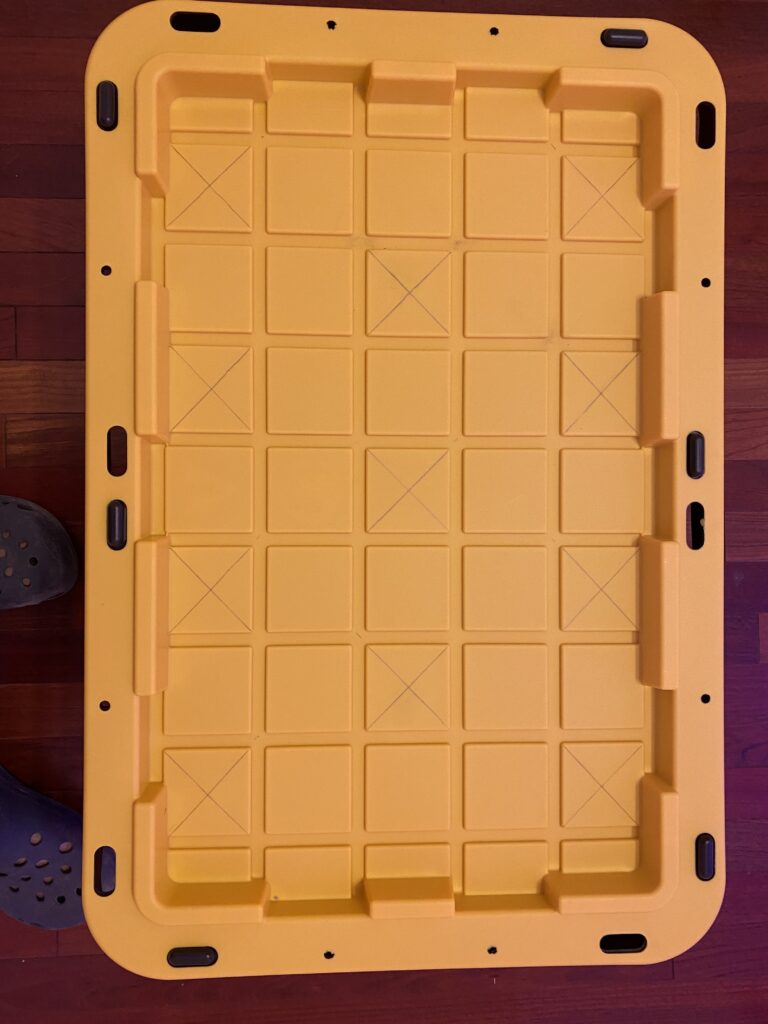
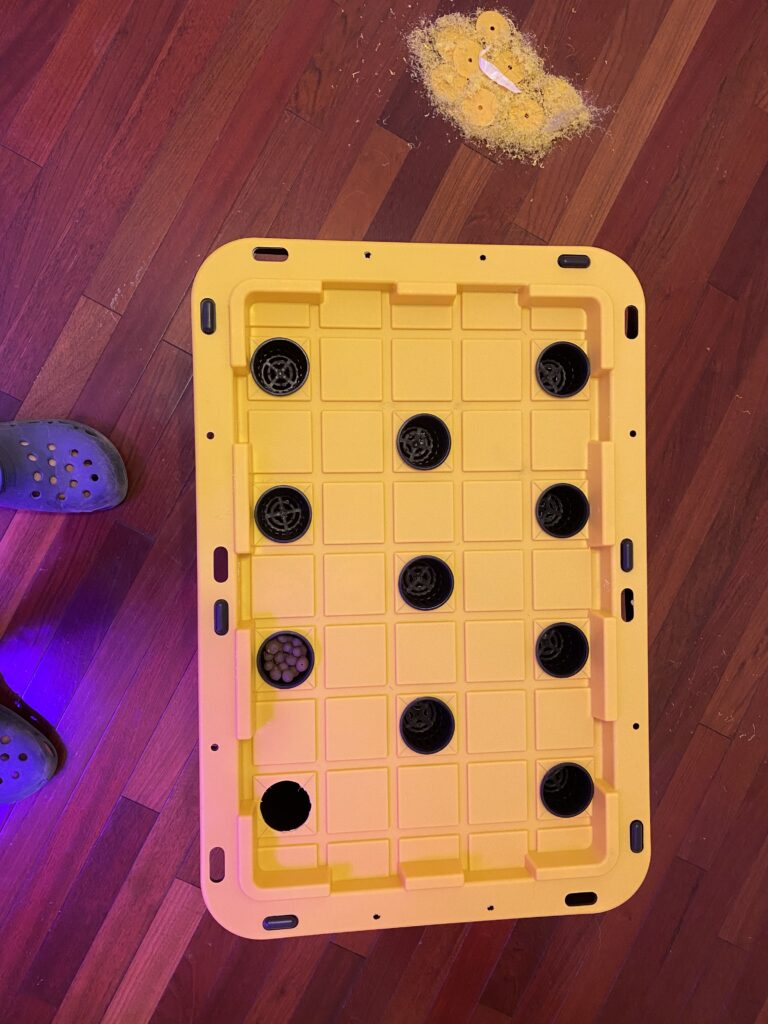
- Place Your Air Stones in the Container: Slide your air pump tubing through the lid and then connect your air stones inside your reservoir.
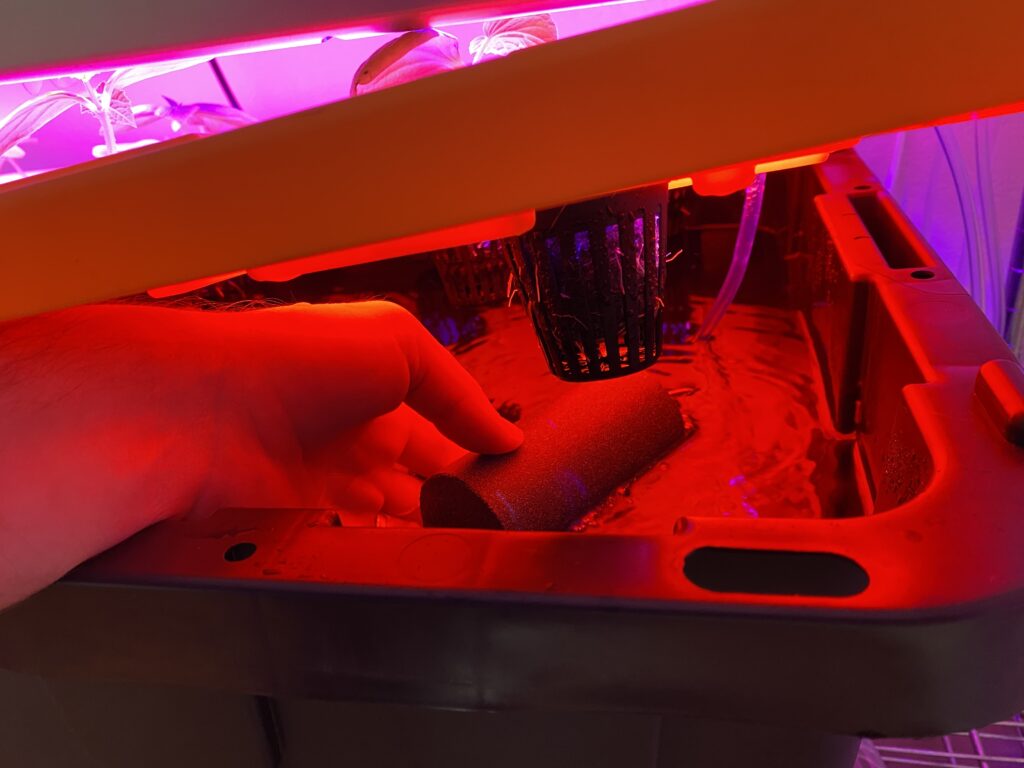
- Fill and Place Your Net Cups: Fill your net cups with the appropriate growing medium and place them into the net cup holes that you drilled.
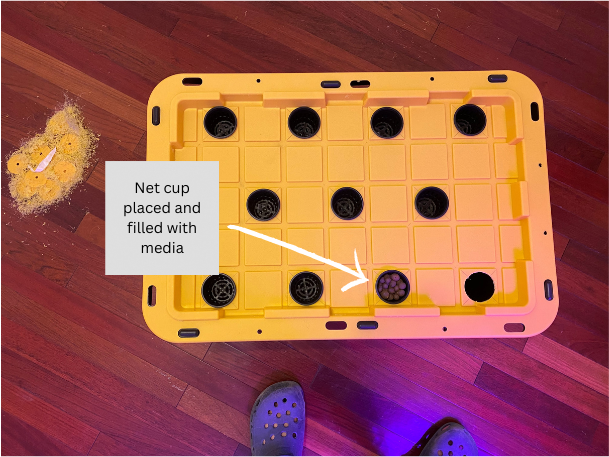
- Fill Up Your Reservoir and Add Nutrients: Fill up your reservoir until your water is making contact (or able to make contact) with the bottom of your net cups. This is also a good time to go ahead and pour in your nutrients. **Note: As we’ve mentioned above, once your roots have grown a little bit and made contact with your water, you can let the water level go down naturally over time until there’s a decent air gap (don’t feel the need to always keep your water level in line with your net cups).
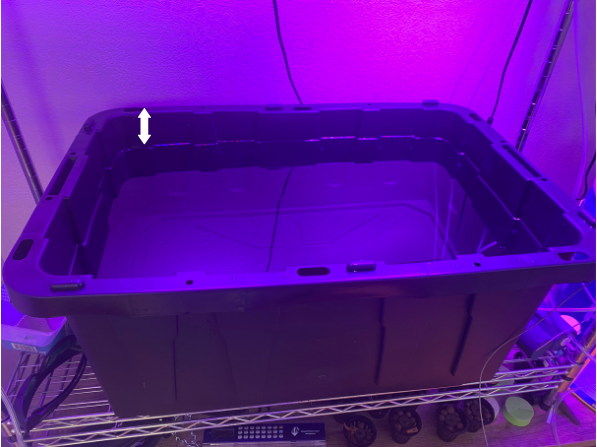
- Add Your Plants In and Turn On Your Air Pump: If everything looks good to go, add in your plants and turn your air pump on (and light of course if you’re growing inside). Now it’s time to sit back and let the growing process take over!
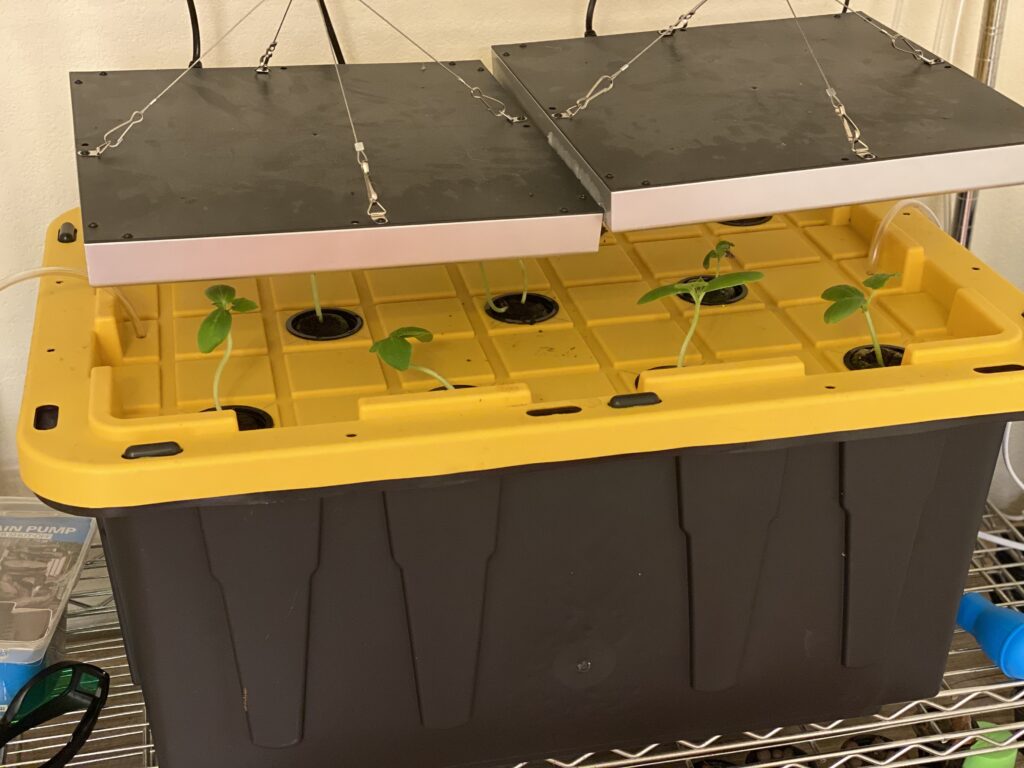
VIII. Troubleshooting Common Issues
Despite its simplicity, you may encounter a few challenges when you first start using a DWC system. Here’s how to troubleshoot some of the most common issues:
Poor Growth or Wilting: This could be due to inadequate nutrient levels or improper pH. Regularly check and adjust your nutrient and pH levels following the instructions provided with your nutrient mix. Check out our PH guide to learn pH needs for commonly grown plants in hydroponics.
Root Disease: If your plants’ roots look brown or slimy, they may have a disease. This issue is often due to light getting into your reservoir, low oxygen, or unsanitary conditions. To avoid this, keep your system clean, ensure your water is well aerated, and consider adding beneficial bacteria to your nutrient solution.
Power Outages: As mentioned earlier, DWC systems rely on continuous power supply to keep the air pump running. Any interruption can quickly lead to your plants’ roots suffocating. Investing in a backup power source, like a generator or a battery-operated air pump, is a wise safety measure.
Algae Growth: Algae will almost certainly build up if light is able to penetrate your reservoir. The only real fix to this is to buy a more opaque container or cover up light-penetrating entry points (such as an unused net cup hole).
Understanding these potential problems and their solutions will equip you to handle any bumps in the road to your hydroponic gardening journey.
IX. Advancing Your DWC System
Once you’re comfortable with a basic DWC setup, consider upgrading it for better results. Advanced systems offer automation, reducing the amount of manual monitoring and adjusting you need to do.
For example, automated pH controllers and nutrient dosers can continuously monitor your nutrient solution’s state and make necessary adjustments, freeing you from the task. Adding a water chiller can help maintain an optimal water temperature, particularly useful in warm climates.
Another upgrade is to move from a stand-alone DWC system to a recirculating one. RDWC systems are more efficient as they circulate the nutrient solution between different containers, keeping nutrient levels more consistent.
X. Conclusion
Venturing into the world of hydroponics is an exciting journey. Whether you’re a novice grower curious about alternative farming methods or a seasoned gardener seeking new challenges, DWC systems offer an appealing path to explore.
With the right information and tools, setting up your DWC system can be a fun and rewarding DIY project. Once your system is up and running, you’ll be able to enjoy the fruits (and vegetables!) of your labor, all while appreciating the eco-friendliness of your hydroponic endeavor.
Remember, learning is a journey. Every challenge you encounter will make you a better hydroponic gardener and bring you one step closer to perfecting your DWC system!
Frequently Asked Questions (FAQs)
Navigating a new growing system can prompt a flurry of questions. Our Frequently Asked Questions section aims to address your queries, providing concise yet comprehensive answers to common concerns about Deep Water Culture systems.
Is deep water culture also called water culture?
Yes, deep water culture is another term for water culture. Both refer to the same hydroponic method where plant roots are suspended in a nutrient solution and oxygenated using an air pump and air stone. While some experts do distinguish between the two (because technically DWC has a water depth that’s deeper than 8-10 inches), “deep water culture” has become the more popular term and is the one that’s widely used today. Thus, it’s probably safe to refer to water culture as “deep water culture” or “DWC.”
What are the types of aeration used in DWC systems?
There are primarily two types of aeration used in DWC systems: air bubbles and falling water. Air bubbles are created by an air pump and air stone that infuse the water with oxygen (as we’ve pictured in the designs above). Falling water aeration, often seen in some larger commercial setups, utilizes the natural oxygenation that occurs when water falls or splashes.
Should the water level be above or below the baskets in a DWC system?
The water level in a DWC system can be either above or below the baskets. It’s beneficial for the baskets to touch the water when the plant is small and roots are not yet long enough to remain submerged. As the plant grows and consumes water, allow an air gap to form between the water and the basket, providing even more oxygen to the roots.
How much oxygen is needed in DWC systems?
In DWC systems, the goal is to create a highly oxygenated environment for the plant roots. While there isn’t a fixed measurement for the “right” amount of oxygen, the system should generate a steady stream of bubbles in the water. If your plants appear unhealthy, inadequate oxygen could be one cause.
Is the Kratky Method also DWC?
The Kratky method is a variation of a standard DWC system, but without an air pump. As the plant grows and consumes water, an air gap is created between the water and the basket, which serves as the plant’s only oxygen source. While this method can be beneficial in areas where electricity is unreliable or non-existent, it may not provide ideal growing conditions for some plants. Read our Kratky Guide to learn more.
How big do the containers need to be in a DWC system?
The container size in a DWC system depends on the type of plant you’re growing and how many plants you have growing in it. For smaller plants or herbs, containers as small as 3-5 gallon buckets may be sufficient. For larger plants, such as tomatoes or peppers, you may need a 5-10 gallon container (or larger) per plant. But ultimately, this is a trial and error process. It may be best to scroll through some pictures online to get a good idea of what size container you need.
How deep should the water be in my DWC container?
The depth of water in your DWC system can vary. As we stated above, the term “Deep Water Culture” is often applied when the water depth is more than 8-10 inches. However, many plants, such as lettuce, can be grown with just 4-6 inches of water.
How is water volume different from water height in my DWC container?
Water volume and water height are two different things in your DWC system. Water volume refers to the total amount of water your system holds. Water height refers to the level of the water in your container, which can vary depending on the container’s shape and size.
In a recirculating DWC system, how big should my central reservoir be?
The size of the central reservoir in a recirculating DWC system should be large enough to accommodate the combined water volume of all the connected growing containers. The exact size will depend on the number and size of your individual growing containers, as well as the type of plants you are growing.
How often should I change the nutrient solution in the reservoir?
The frequency of changing the nutrient solution in a DWC system’s reservoir can vary based on the size of your system, the type of plants you’re growing, and their growth stage. However, a common rule of thumb is to completely change out the nutrient solution every two to three weeks. Regular checks on nutrient levels and pH are recommended in between changes to ensure optimal plant health.
Can I just top off the solution from time to time instead of changing it out entirely?
This is the debate of all debates in the hydroponics community and depending on who you talk to, the answer is always different. HOWEVER, we recommend the following:
if you’re a general hobbyists, it’s really up to you and it depends on how serious you want to take it. If you’re growing for a farmers market, it may be best to “go by the book” and completely change the water out. If you’re just growing for yourself, however, there’s no reason you can’t just top it off from time to time and call it a day. As long as your cleaning your containers between every harvest and testing your water, your results shouldn’t be that different.






